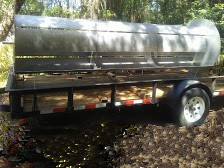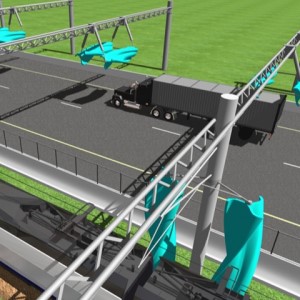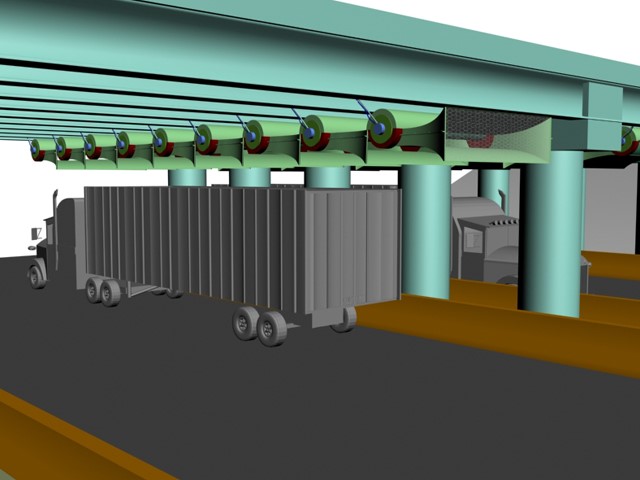WindAge Traffic-Driven Wind Generators are made in America. They produce clean, renewable electricity by harvesting and converting free energy from the turbulent, high-speed air created by moving vehicles, and are augmented by the local prevailing wind. They reflect simplicity itself through the engineering ideal of having only one moving part. This simplicity manifests itself as long-term reliability, with a projected working life of over 20 years.
Advantages
WindAge Traffic Driven Wind Generators (TDWG) Advantages
- WindAge TDWG Systems Free Energy Sources WindAge TDWG assemblies produce clean power in a new way by innovatively utilizing high speed airflow created by moving vehicles and natural wind conditions.
- WindAge TDWG Systems Ease of Installation WindAge TDWG assemblies are designed with adjustable mounting arms for easily adaptable installation over unpredictably angled traffic lanes. This adjustability also enables the optimum compromise between a safe distance and maximum output.
- WindAge TDWG Systems are cost effective to operate WindAge TDWG assemblies feature the first patented use of magnetic bearings for wind generators. These bearings are powered by either generator-produced bleed DC current or by integrated permanent magnets. By emitting little heat and no friction, they require no lubrication and operate virtually maintenance free.
- WindAge TDWG Systems are cost effective to install. WindAge TDWG assemblies are designed for widespread use under existing structures such as the numerous overpasses and overhead sign frames on high-density, high-speed expressways and railways. They can also be installed in airports, existing wind farms, and on hi-rise building rooftops. Due to the mounting arm design and their manageable size and weight, they can be quickly installed. A typical roadway overpass installation of 6 units can be completed within 24 hours.
- WindAge TDWG Systems Ease of Maintenance WindAge TDWG Systems are highly efficient and virtually maintenance free because they utilize wind generators with magnetic bearings that produce virtually no heat or friction, and require no lubrication. WindAge TDWG Systems require no governor systems such as those required on propeller style windmills.
- WindAge TDWG Systems Adaptable Configurations WindAge rotor assemblies can be made in a variety of configurations, using either helical vanes or vanes made like an airplane wing, to provide lift. Further, they can be made in either plastic or aircraft aluminum, and include ducting to enhance the wind velocity through the Venturi Effect.
- WindAge TDWG Systems Patented Innovation WindAge TDWG Systems assemblies feature the first patented wind generator utilization of magnetic bearings. These are efficiently powered by generator produced bleed DC current. Plus, with no heat and minimal friction, they require no lubrication and operate virtually maintenance free.
- WindAge TDWG Systems Safety Using the TDWG adjustable mounting arms, all road and rail installations maintain at least a 6-inch safety buffer between the vehicle's maximum legal height limit and the rotor assembly. If this is exceeded and the passing vehicle accidentally strikes the TDWG, the rotor vanes will simply shatter, with little energy being transferred to the vehicle.
- WindAge TDWG Systems expand the clean energy paradigm WindAge rotor assemblies can be cast from recycled plastic, thereby decreasing the overall carbon footprint associated with their manufacture, as well as helping to reduce waste in oceans and landfills.
- WindAge TDWG Systems can combine with Human Energy Harvesters and solar photovoltaic (PV) panels at Rest Stops to create the foundation for clean, efficient, and reliable alternate-fuel-vehicle recharging sites. When used in this combination, the long-recognized problem with the intermittency of alternate energy is largely solved, and the door to the Hydrogen Age can open further.
TDWG Prototypes
WindAge, LLC offers a range of existing products and systems
- All
- CAD
- Photos
- Videos

TDWG Overpass Mountings
Each TDWG Rotor Assembly is designed with adjustable mounting arms for easily-adapted installations over angled traffic lanes and various mounting elevations.
Read
More

TDWG Rotor Assemblies
WindAge TDWG Rotor Assemblies produce clean power by utilizing free energy from the turbulent air created by moving vehicles, augmented by the prevailing wind.
Read
More

Prototype
Read
More
Applications
Highways and railways are the WindAge TDWG System Primary Applications.

Highways & Overpasses
The output from these units can power rest stops, roadside lighting, digital Amber Alert signs, or be sent to the local grid in what is commonly called a "Community Wind Microgrid" program. The most suitable overpass candidates will be oriented to capture the local ambient / prevailing wind. To increase efficiency, these units can be installed on both directions of highway near a rest stop, so that cable runs are kept short, and electrical resistance is kept to a minimum. Read More...

Railways
A major advantage of using the TDWG with train traffic is the potential to capture energy from three sides, whereas the need to change a flat tire and have a safety lane on normal roads precludes anything but an upper mounting. Read More...
Future Development
WindAge, LLC is committed to continuous research. From this point, incremental efficiency improvements can still be had, even though a light rotor combined with magnetic bearings is already quite efficient. The results of the CFD analysis will suggest the direction fine tuning should go in relation to shrouding, ducting, spacing under an overpass, and any vehicle drag factors.
Proof Of Concept
WindAge, LLC constructed several full-scale TDWG prototypes to discover whether significant energy could be harvested from passing commercial traffic.
-
TDWG Concept Validation
The most important finding from the Prototype I dragstrip testing was that as the rotor assembly naturally decelerated through internal friction and decreasing wind velocity, the truck passing at 70mph increased the acceleration and output over 50%. This effectively "proved" the basic concept that passing traffic could generate useful electrical power. A second important finding was that the ambient wind should be captured whenever possible to keep the rotor momentum high, in preparation for the next passing vehicle.
A major university, UCF, was commissioned to perform a Computational Fluid Dynamics review of the second WindAge prototype, a 3-bladed helical rotor design of epoxy-coated foam. The results are available in the Report here -
TDWG Outputs
TDWG full-scale Prototype II was installed on a Florida Turnpike overpass in conjunction with the Florida DOT. In the performance graphs shown here, the TDWG output is a function of traffic density and speed. The October and November 2013 outputs performance shows a clear relationship to city rush hour traffic as it flows four times a day. This is important because it reveals that the TDWG output is not just a function of the ambient wind. The output shown can be boosted with more generator and rotor research, as well as physical enhancements such as ducting and magnetic bearings.
- Vehicle Drag Rebuttal
-
Testing Goals
The primary goal of Prototype I dragstrip testing was to validate the theory that passing vehicles could have a significant accelerative and energy-boosting effect on a wind rotor's speed. This was accomplished during a test of the TDWG in conjunction with an over-the road-tractor and 53' foot long livestock trailer. On a digital meter, the output increased more than 50% over the ambient wind output.
The primary goal of Prototype II overpass testing was to discern whether the TDWG ambient wind performance would be enhanced by real-world traffic. The two graphs included above reveal that it definitely is enhanced.
Prototype III, using a different rotor design in aircraft aluminum, was built with an “open frame” (shaftless), American-made generator. The goal of Prototype III was to determine the efficacy of a radically different rotor vane design, and whether aluminum would be a suitable material. Unfortunately, its magnets were too powerful to work with the open frame generator configuration, and the necessary air gap could not be maintained, so it had to be temporarily shelved.Prototype III

- Power Distrubution System








